An Optimal Scheduling Method for Distribution Network Clusters Considering Source–Load–Storage Synergy
Abstract
:1. Introduction
2. Distribution Network Clustering Division Methodology
2.1. Modularity Metrics Based on Electrical Distance
2.2. Improved Active Power Balance Metrics
2.3. Comprehensive Metrics for Clustering Division
2.4. Cluster Segmentation Algorithm
3. An Economic Optimal Dispatch Model for Distribution Network Clusters
3.1. Distribution Network Cluster Structure
3.2. Objective Function
- 1.
- Investment costs
- 2.
- Operation and maintenance costs
- 3.
- Cluster’s purchase and sale of electricity costs
- 4.
- Inter-cluster power interaction costs
- 5.
- Network loss costs in distribution networks
- 6.
- Cluster interaction power penalties with a higher-level grid
3.3. Restrictive Condition
- Power balance constraint
- 2.
- Cluster and upper-grid power transfer constraints
- 3.
- Inter-cluster power transfer constraints
- 4.
- Energy storage charge/discharge constraints
- 5.
- Energy storage power and capacity constraints
- 6.
- Charge state of energy storage
4. Data and Methods of Simulation
4.1. Data and Method of Distribution Network Cluster Division
4.2. Data and Methods for Optimal Scheduling of Distribution Network Clusters
5. Results and Discussion of the Experiment
5.1. Results of Distribution Network Clustering Division
5.2. Discussion of the Result of Distribution Network Cluster Division
5.3. Results of Optimal Scheduling of Distribution Network Clusters
5.4. Discussion of the Results of Distribution Network Cluster Optimization Scheduling
6. Conclusions
- The division of distribution networks using a comprehensive metrics approach to de-apply cluster optimization scheduling objectives can give full play to the advantages of cluster scheduling. Furthermore, a GA algorithm with simulated annealing doubles the computational efficiency of the basic GA algorithm while guaranteeing the validity of the computational results and realizing the efficient solution of distribution network cluster division.
- Considering the power interaction cost between clusters based on time-sharing tariffs in the optimal scheduling model can effectively reduce the amount of power sent back by the clusters to the higher-level grid, alleviate the power supply pressures of the higher-level grid, and at the same time, reduce energy-storage outputs and system-operation costs. The total operating costs can be reduced by 2.87% compared with optimal scheduling without distribution network clustering division.
- When energy storage is also considered during planning and operation, the distribution network’s comprehensive performance index can improve by 1.4% compared with considering only source and load. Not only is the balance between power and load in the cluster improved, but also the functionality of the distribution network is enhanced. In the scheduling phase, the energy storage regulating capacity can be fully utilized to improve costs.
- Dividing the distribution network into regions to effectively improve the regional distribution network’s capacity to absorb DG can improve energy efficiency, reduce inter-regional flow to reduce energy consumption, and enhance sustainability characteristics of new energy sources in distribution networks.
Author Contributions
Funding
Informed Consent Statement
Data Availability Statement
Conflicts of Interest
Glossary
| Description of Some of the Symbols in This Article | |
| |
| active power. | |
| reactive power. | |
| active power–voltage phase angle sensitivity matrix. | |
| active power–voltage magnitude sensitivity matrix. | |
| reactive power–voltage phase angle sensitivity matrix. | |
| reactive power–voltage magnitude sensitivity matrix. | |
| active voltage sensitivity matrix. | |
| reactive voltage sensitivity matrix. | |
| ratio of voltage change values at node and node . | |
| active node voltage sensitivities of node itself. | |
| reactive node voltage sensitivities of node itself. | |
| active nodal voltage sensitivities between nodes. | |
| reactive nodal voltage sensitivities between nodes. | |
| weight of the edge connecting node and node . | |
| sum of all edge weights in the whole network. | |
| sum of the weights of all connected edges of nodes . | |
| sum of the weights of all connected edges of nodes . | |
| indicates that the two node regions belong to the same state. | |
| active balance of cluster. | |
| net power of cluster at time . | |
| total active dissipation capacity that can be provided by the DGs and ES in cluster . | |
| minimum active power required. | |
| active sensitivity of cluster. | |
| active voltage sensitivity of node in cluster . | |
| active balance of the whole network. | |
| number of cluster divisions. | |
| weighting factor. | |
| comprehensive indicator of cluster classification. | |
| cost. | |
| fixed annual rate. | |
| DG capacity of cluster. | |
| rated capacity of the energy storage. | |
| rated power of the energy storage. | |
| investment cost per unit of DG capacity. | |
| unit capacity cost of energy storage. | |
| unit power cost of energy storage. | |
| DG operation and maintenance costs. | |
| energy storage operation and maintenance costs. | |
| DG of cluster for a force at moment . | |
| output of stored energy of cluster at moment . | |
| power of cluster interacting with a higher-level grid at moment . | |
| power purchase price at time . | |
| price of electricity sold at moment . | |
| time-share price of electricity purchased and sold between clusters at time . | |
| power transmitted between moments of cluster through contact lines . | |
| network loss of cluster branch at moment . | |
| power loss cost. | |
| power transmitted from cluster to the higher-level grid at time . | |
| penalty factor. | |
| load of cluster at time . | |
| outputs of wind power for cluster at time . | |
| outputs of photovoltaic power for cluster at time . | |
| stored energy being charged/discharged for cluster at time . | |
| power transferred between clusters. | |
| lower limits of power transfer. | |
| upper limits of power transfer. | |
| lower power limits of the inter-cluster contact line. | |
| upper power limits of the inter-cluster contact line. | |
| lower limits of the energy storage power capacity. | |
| upper limits of the energy storage power capacity. | |
| energy storage capacity at moment . | |
| energy storage charging efficiencies. | |
| energy storage discharging efficiencies. | |
| lower bounds of the charge state. | |
| bounds of the charge state. | |
| initial charge state. | |
| |
| nodal. | |
| nodal. | |
| clusters. | |
| time. | |
| investor. | |
| capacity. | |
| power. | |
| DG operation and maintenance. | |
| DG operation and maintenance. | |
| distributed generator. | |
| energy storage. | |
| power network. | |
| time-sharing tariff. | |
| transmission lines. | |
| purchase of electricity. | |
| selling electricity. | |
| network loss. | |
| power loss. | |
| electrical load. | |
| wind power output. | |
| photovoltaic output. | |
| energy storage power. | |
| energy storage charge state. | |
References
- Li, S.; Hu, Y. A multi-criteria framework to evaluate the sustainability of renewable energy: A 2-tuple linguistic grey relation model from the perspective of the prospect theory. Sustainability 2022, 14, 4419. [Google Scholar] [CrossRef]
- Khatami, F.; Goharian, E. Beyond profitable shifts to green energies, towards energy sustainability. Sustainability 2022, 14, 4506. [Google Scholar] [CrossRef]
- Yang, X.D.; Xu, C.B.; Hu, H.B.; Yao, W.; Wen, J.Y.; Zhang, Y.B. Flexibility provisions in active distributed network with uncertainties. IEEE Trans. Sustain. Energy 2021, 12, 553–567. [Google Scholar]
- Wang, X.Q.; Sheng, X.D.; Qiu, W.X.; He, W.L.; Xu, J.; Xin, Y.; Jv, J.B. Fault reconfiguration strategies of active distribution network with uncertain factors for maximum supply capacity enhancement. IEEE Access 2022, 10, 72373–72380. [Google Scholar] [CrossRef]
- Shushpanov, I.; Suslov, K.; Ilyushin, P.; Sidorov, D.N. Towards the flexible distribution networks design using the reliability performance metric. Energies 2021, 14, 6193. [Google Scholar] [CrossRef]
- Zhong, J.; Li, K.J.; Sun, K.Q.; Liu, J.; Chang, X. Source-load-storage coordinated optimization dispatch for distribution networks considering source-load uncertainties. In Proceedings of the 2022 4th Asia Energy and Electrical Engineering Symposium (AEEES), Chengdu, China, 25–28 March 2022. [Google Scholar]
- Rao, Y.; Cui, X.; Zou, X.; Ying, L.; Tong, P.; Li, J. Research on distributed energy storage planning-scheduling strategy of regional power grid considering demand response. Sustainability 2023, 15, 14540. [Google Scholar] [CrossRef]
- Rao, S.N.V.B.; Kumar, X.V.P.; Pradeep, D.J.; Reddy, C.P.; Kraiem, H.; Al-Asad, J.F. Power quality improvement in renewable-energy-based microgrid clusters using fuzzy space vector PWM controlled inverter. Sustainability 2022, 14, 4663. [Google Scholar] [CrossRef]
- Miranbeigi, M.; Iman-Eini, H. Hybrid modulation technique for grid-connected cascaded photovoltaic systems. IEEE Trans. Smart Grid 2016, 63, 7843–7853. [Google Scholar] [CrossRef]
- Kroposki, B.; Bernstein, A.; King, J.; Vaidhynathan, D.; Zhou, X.Y.; Chang, C.Y.; Anese, E.D. Autonomous energy grids: Controlling the future grid with large amounts of distributed energy resources. IEEE Power Energy Mag. 2023, 21, 87–96. [Google Scholar] [CrossRef]
- Leksawat, S.; Schmelter, A.; Ortjohann, E.; Kortenbruck, J.; Holtschulte, D.; Premgamone, T.; Khaola-iead, K.; Morton, D. Demonstration of cluster-based power system automation for future smart grids. In Proceedings of the 2016 IEEE International Energy Conference, Leuven, Belgium, 4–8 April 2016. [Google Scholar]
- Wirasanti, P.; Ortjohann, E.; Schmelter, A.; Morton, D. Clustering power systems strategy the future of distributed generation. In Proceedings of the International Symposium on Power Electronics Power Electronics, Electrical Drives, Automation and Motion, Sorrento, Italy, 20–22 June 2012. [Google Scholar]
- Hui, H.; Li, R.; Zhao, Y.; Wang, M.; Mao, Z.Y.; Wang, X.R. Optimal Allocation Method of PV-Storage System in Clustered Distribution Network with Balanced Economy and Reliability. In Proceedings of the 2022 12th International Conference on Power and Energy Systems (ICPES), Guangzhou, China, 23–25 December 2022. [Google Scholar]
- Hoger, M.; Klimo, M.; Tkac, M. Clustering Technique for Enhanced Optimization and Control of Distribution Networks. In Proceedings of the 2024 ELEKTRO(ELEKTRO), Zakopane, Poland, 20-22 May 2024. [Google Scholar]
- Vallee, F.; Brunieau, G.; Pirlot, M.; Deblecker, O.; Lobry, J. Optimal wind clustering methodology for electrical network adequacy studies using non sequential Monte Carlo simulation. In Proceedings of the 2011 International Conference on Clean Electrical Power (ICCEP), Ischia, Italy, 14–16 June 2011. [Google Scholar]
- Biserica, M.; Foggia, G.; Chanzy, E.; Passelergue, J.C. Network partition for coordinated control in active distribution networks. In Proceedings of the 2013 IEEE Grenoble Conference, Grenoble, France, 16–20 June 2013. [Google Scholar]
- Preda, T.N.; Uhlen, K.; Nordgard, D.E. Clustering distributed generation using the instantaneous Euclidean Distance in polar coordinates. In Proceedings of the IEEE PES ISGT Europe 2013, Lyngby, Denmark, 6–9 October 2013. [Google Scholar]
- Heslop, S.F.; MacGill, I.F. Operational characteristics of a cluster of distributed photovoltaic systems. In Proceedings of the 2011 IEEE PES Innovative Smart Grid Technologies, Perth, WA, Australia, 13–16 November 2011. [Google Scholar]
- Wang, M.; Li, F.; Hong, F.; Wang, S.C. Application of improved cluster division method in active distribution network. In Proceedings of the 2021 5th International Conference on Green Energy and Applications (ICGEA), Singapore, 6–8 March 2021. [Google Scholar]
- Ding, M.; Liu, X.F.; Bi, R.; Hu, D.; Ye, B.; Zhang, J.J. A cluster segmentation approach for high penetration distributed power clusters using comprehensive performance metrics. Autom. Electr. Power Syst. 2018, 42, 47–52+141. (In Chinese) [Google Scholar]
- Vinothkumar, K.; Selvan, M.P. Hierarchical agglomerative clustering algorithm method for distributed generation planning. Int. J. Electr. Power Energy Syst. 2013, 56, 259–269. [Google Scholar] [CrossRef]
- Lv, N.J.; Liu, X.T.; Hu, J.J.; Zhang, H.B. Cluster partition method development for high penetration of distributed photovoltaics using intelligent algorithm and K-means. In Proceedings of the 2022 IEEE 5th International Conference on Electronics Technology (ICET), Chengdu, China, 13–16 May 2022. [Google Scholar]
- Cao, D.; Zhao, J.B.; Hu, W.H.; Ding, F.; Huang, Q.; Chen, Z.; Blaabjerg, F. Data-driven multi-agent deep reinforcement learning for distribution system decentralized voltage control with high penetration of PVs. IEEE Trans. Smart Grid 2021, 12, 4137–4150. [Google Scholar] [CrossRef]
- Kiran, D.; Abhyankar, A.R.; Panigrahi, B.K. Hierarchical clustering based zone formation in power networks. In Proceedings of the 2016 National Power Systems Conference, Bhubaneswar, India, 19–21 December 2016. [Google Scholar]
- Liao, K.L.; Wu, G.L.; Weng, H.D.; Zhang, L.Y.; Liu, L.J. Optimal configuration of capacity for hybrid energy storage based on ISDPC–K-means clustering and cluster division. In Proceedings of the 2023 Panda Forum on Power and Energy (PandaFPE), Chengdu, China, 27–30 April 2023. [Google Scholar]
- Zhao, B.; Xu, Z.C.; Xu, C.; Wang, C.S. Network partition-based zonal voltage control for distribution networks with distributed PV systems. IEEE Trans. Smart Grid 2018, 9, 4087–4098. [Google Scholar] [CrossRef]
- Zhao, J.J.; Zhu, J.D.; Li, Z.K.; Zhang, Y.; Liu, S.; Li, X.B. Two-stage intraday distributed optimal scheduling of distribution networks considering robust balancing of flexibility supply and demand. Autom. Electr. Power Syst. 2022, 46, 61–71. (In Chinese) [Google Scholar]
- Dong, H.Z.; Li, S.D.; Dong, H.Y.; Tian, Z.B. Coordinated scheduling strategy for distributed generation considering uncertainties in smart grids. IEEE Access 2020, 8, 86171–86179. [Google Scholar] [CrossRef]
- Miao, G.X.; Wang, X.; Yuan, L.; Wei, H.; Hui, M. Two-tier optimal scheduling of micro-grid cluster distribution system based on energy interaction. In Proceedings of the 2023 IEEE Sustainable Power and Energy Conference (ISPEC), Chongqing, China, 28–30 November 2023. [Google Scholar]
- Hu, D.; Ding, M.; Sun, L.; Zhang, J.J. Planning of high renewable-penetrated distribution systems considering complementarity and cluster partitioning. Energies 2019, 12, 2090. [Google Scholar] [CrossRef]
- Su, D.W.; Hao, Y.C.; Li, W.Q.; Dai, R.P.; Zhou, X.F. Cluster division and optimal scheduling of offshore wind power with energy storage based on fast unfolding algorithm. In Proceedings of the 2022 IEEE 5th International Electrical and Energy Conference (CIEEC), Nangjing, China, 27–29 May 2022. [Google Scholar]
- Su, H.Z.; Li, P.; Fu, X.P.; Yu, L.; Wang, C.S. Augmented sensitivity estimation based voltage control strategy of active distribution networks with PMU measurement. IEEE Access 2019, 7, 44987–44997. [Google Scholar] [CrossRef]
- Girvan, M.; Newman, M.E.J. Community structure in social and biological networks. Proc. Natl. Acad. Sci. USA 2002, 99, 7821–7826. [Google Scholar] [CrossRef]
- Chai, Y.Y.; Guo, L.; Wang, C.S.; Zhao, Z.Z.; Du, X.F.; Pan, J. Network partition and voltage coordination control for distribution networks with high penetration of distributed PV units. IEEE Trans. Power Syst. 2018, 33, 3396–3407. [Google Scholar] [CrossRef]
- Newman, M.E.J.; Girvan, M. Finding and evaluating community structure in networks. Phys. Rev. E 2004, 69, 026113. [Google Scholar] [CrossRef]
- Newman, M.E.J.; Girvan, M. Fast algorithm for detecting community structure in networks. Phys. Rev. E 2004, 69, 066133. [Google Scholar] [CrossRef]
- Du, H.W.; Wei, T.Z.; Xia, D.; Zhou, S.Y.; Han, T. Reactive voltage self-regulation and coordination control in distribution networks based on cluster dynamic partition. Autom. Electr. Power Syst. 2024, 48, 171–181. (In Chinese) [Google Scholar]
- Ding, J.; Zhang, Q.; Hu, S.; Wang, Q.; Ye, Q. Clusters partition and zonal voltage regulation for distribution networks with high penetration of PVs. IET Gener. Transm. Distrib. 2018, 12, 6041–6051. [Google Scholar] [CrossRef]
- Li, X.; Li, G.M.; Wang, Z.F.; Kuang, Z.J.; Chen, T.W.; Wang, T.L. A bi-level planning method of distributed renewable energy based on cluster division. In Proceedings of the 2022 12th International Conference on Power and Energy Systems (ICPES), Guangzhou, China, 23–25 December 2022. [Google Scholar]
- Seungchan, J.; Jae-Young, O.; Jaeho, L.; Seokhwa, O.; Moon, H.S.; Zhang, C.; Gadh, R.; Yoon, Y.O. Hybrid genetic algorithm with k-nearest neighbors for radial distribution network reconfiguration. IEEE Trans. Smart Grid 2024, 15, 2614–2624. [Google Scholar]
- Wang, W.T.; Tian, J. An improved nonlinear tuna swarm optimization algorithm based on circle chaos map and levy flight operator. Electronics 2022, 11, 3678. [Google Scholar] [CrossRef]
- Deng, S.; Yuan, C.G.; Yang, J.Q.; Zhou, A.H. Distributed mining for content filtering function based on simulated annealing and gene expression programming in active distribution network. IEEE Access 2017, 5, 2319–2328. [Google Scholar] [CrossRef]
- Mafarja, M.M.; Mirjalili, S. Hybrid whale optimization algorithm with simulated annealing for feature selection. Neurocomputing 2017, 260, 302–312. [Google Scholar] [CrossRef]
- Liu, H.; Li, J.F.; Ge, S.Y.; He, X.T.; Li, F.R.; Gu, C.H. Distributed Day-Ahead Peer-to-Peer Trading for Multi-Microgrid Systems in Active Distribution Networks. IEEE Access 2020, 8, 66961–66967. [Google Scholar] [CrossRef]
- Yang, J.; Gao, H.J.; Ye, S.Y.; Lu, L.; Liu, Y.B.; Liu, J.Y. Applying multiple types of demand response to optimal day-ahead stochastic scheduling in the distribution network. IET Gener. Transm. Distrib. 2020, 14, 4509–4519. [Google Scholar] [CrossRef]
- Dolatabadi, S.H.; Ghorbanian, M.; Siano, P.; Hatziargyriou, N.D. An enhanced IEEE33 Bus benchmark test system for distribution system studies. IEEE Trans. Power Syst. 2021, 36, 2565–2572. [Google Scholar] [CrossRef]
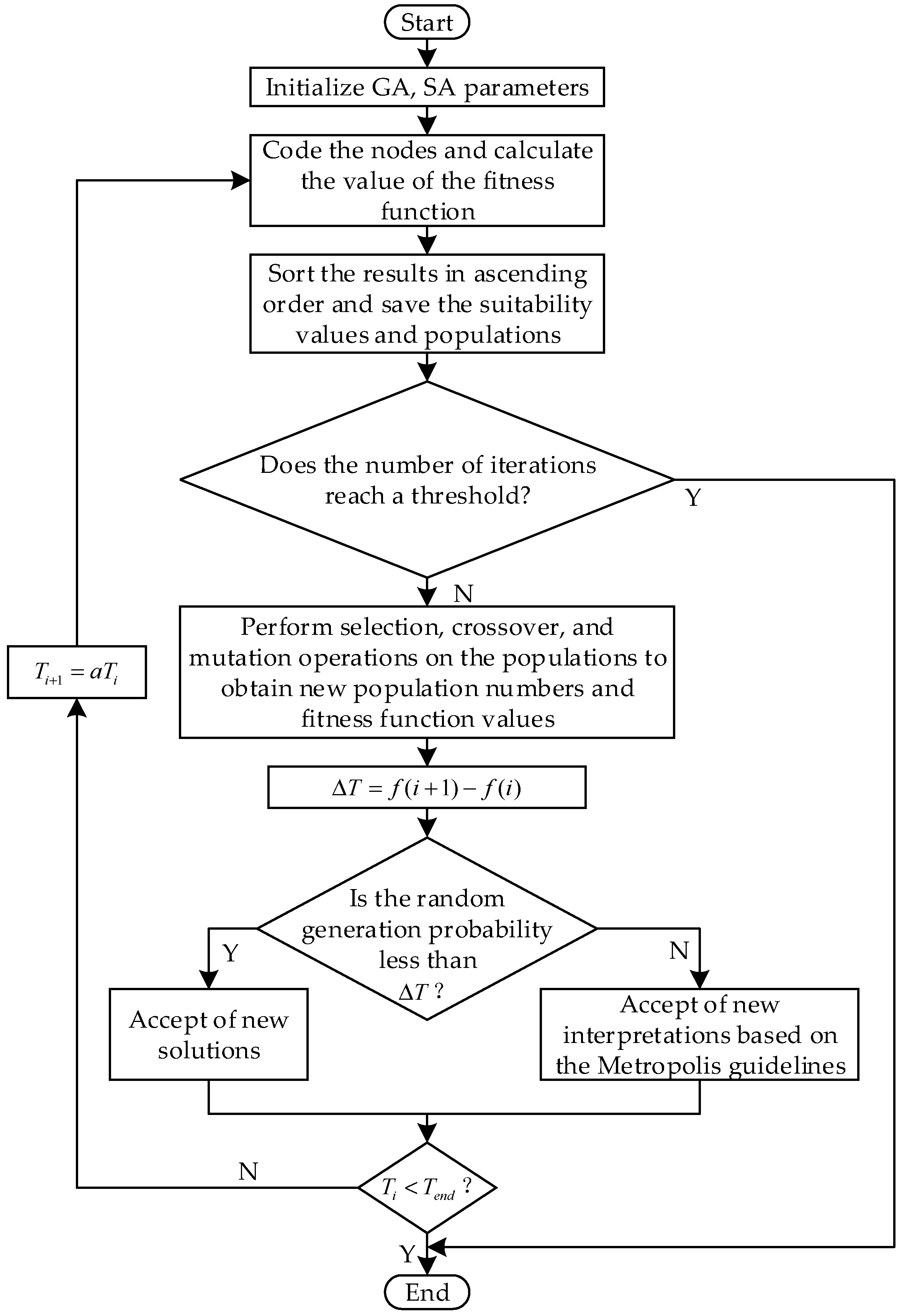

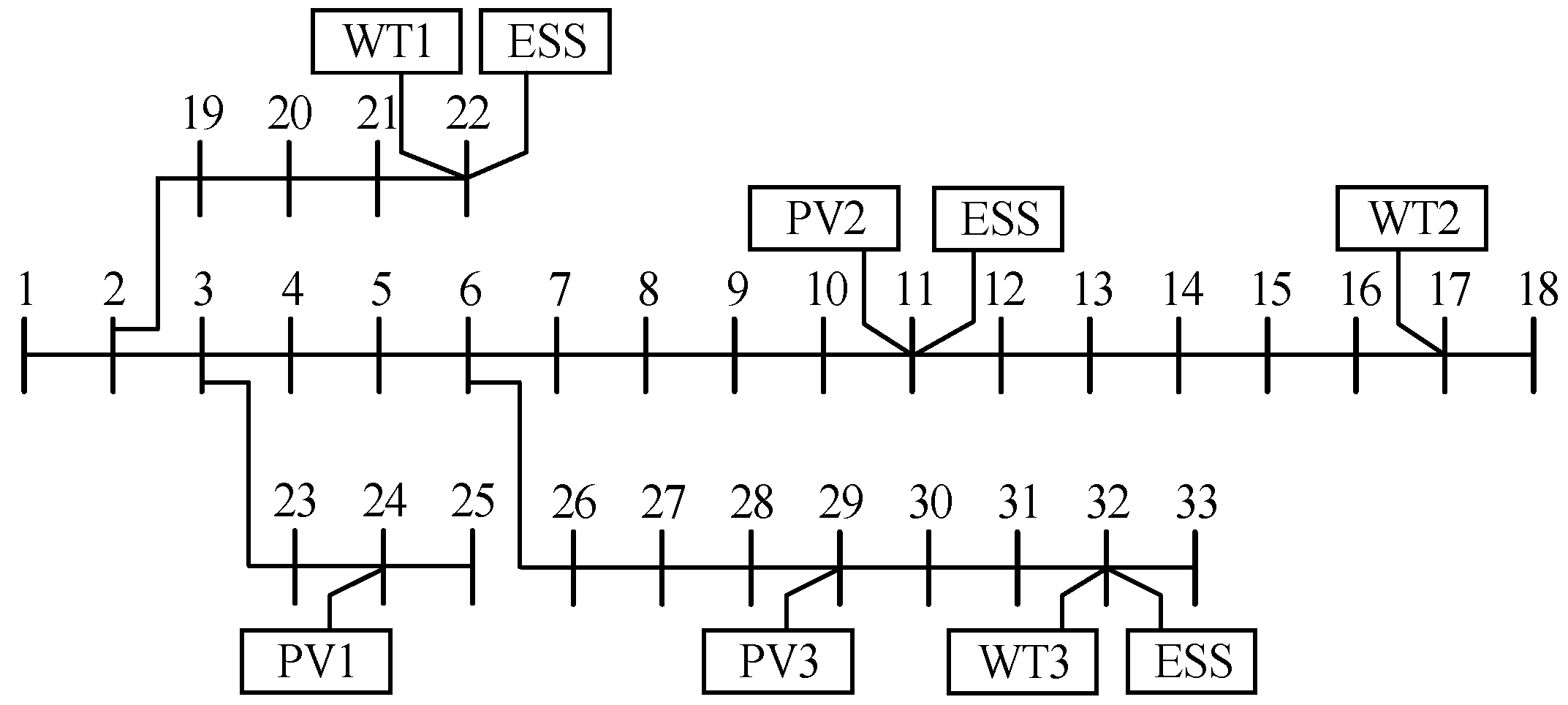
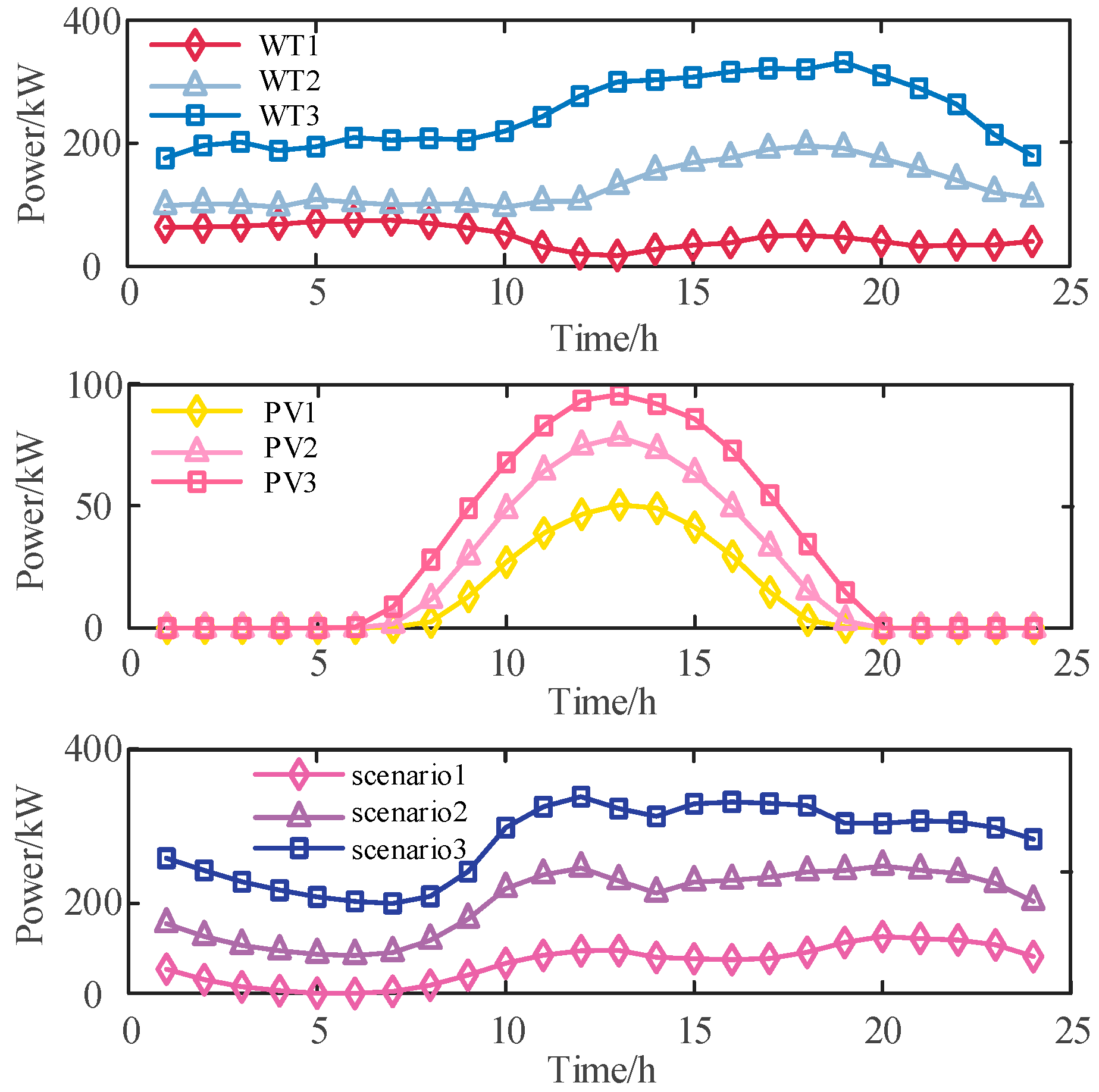
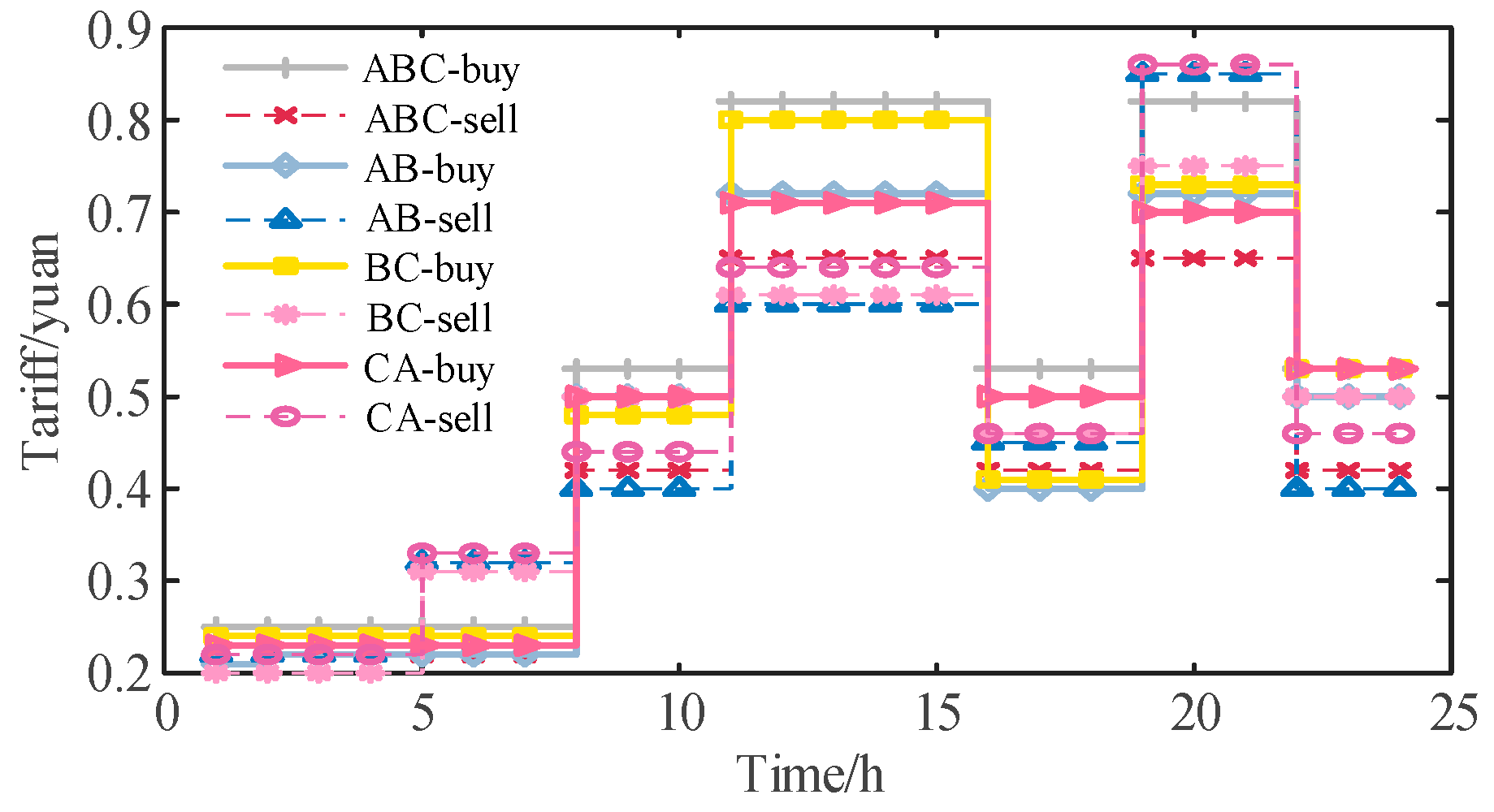



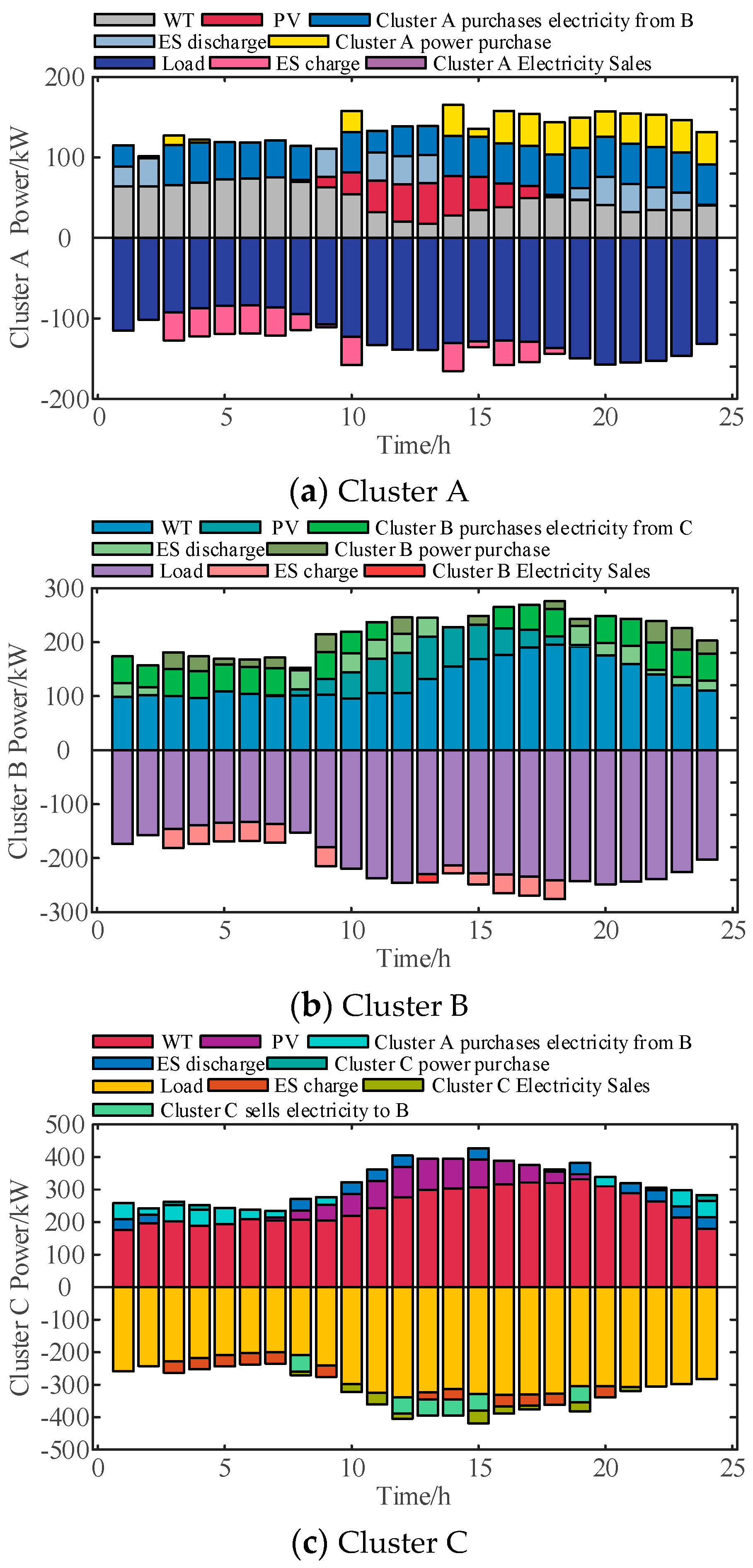

| Parametric | Value |
|---|---|
| Wind power capacity investment costs (CNY/kW) | 2055/CNY |
| Wind power capacity O&M costs (CNY/kWh) | 0.57/CNY |
| PV capacity investment costs (CNY/kW) | 2675/CNY |
| PV capacity O&M Costs (CNY/kWh) | 0.72/CNY |
| Energy storage capacity costs (CNY/kW) | 200/CNY |
| Energy storage power cost (CNY/kWh) | 1100/CNY |
| Energy storage O&M costs (CNY/kWh) | 0.6/CNY |
| Annual interest rate | 8% |
| Planning horizon | 20 years |
| Scenario | Number of Clusters | Modularity Indicators | Power Balance Indicator | ||
|---|---|---|---|---|---|
| 1 | 0.5 | 0.5 | 3 | 0.6958 | 0.6711 |
| 2 | 0.5 | 0.5 | 3 | 0.6953 | 0.6921 |
| Optimized Scheduling | Investment Costs | Operation and Maintenance Costs | Cluster Purchase and Sale of Electricity Costs | Inter-Cluster Power Interaction Costs | Network Loss Costs in Distribution Networks | Cluster Interaction Power Penalties with the Higher-Level Grid | Total Cost |
|---|---|---|---|---|---|---|---|
| Scheme 1 | 17,305/CNY | 7761.1/CNY | 1184.9/CNY | / | 72.08/CNY | 587.1/CNY | 26,911/CNY |
| Scheme 2, cluster A | 2761.8/CNY | 1097.8/CNY | 270.86/CNY | 491.13/CNY | 88.5/CNY | 88.08/CNY | 4806.5/CNY |
| Scheme 2, cluster B | 5301.8/CNY | 2390.3/CNY | 147.97/CNY | 359.37/CNY | 66.86/CNY | 8355/CNY | |
| Scheme 2, cluster C | 8941.7/CNY | 4213.3/CNY | −99.08/CNY | −31.68/CNY | 48.76/CNY | 13,156/CNY |
Disclaimer/Publisher’s Note: The statements, opinions and data contained in all publications are solely those of the individual author(s) and contributor(s) and not of MDPI and/or the editor(s). MDPI and/or the editor(s) disclaim responsibility for any injury to people or property resulting from any ideas, methods, instructions or products referred to in the content. |
© 2024 by the authors. Licensee MDPI, Basel, Switzerland. This article is an open access article distributed under the terms and conditions of the Creative Commons Attribution (CC BY) license (https://creativecommons.org/licenses/by/4.0/).
Share and Cite
Qiu, S.; Deng, Y.; Ding, M.; Han, W. An Optimal Scheduling Method for Distribution Network Clusters Considering Source–Load–Storage Synergy. Sustainability 2024, 16, 6399. https://doi.org/10.3390/su16156399
Qiu S, Deng Y, Ding M, Han W. An Optimal Scheduling Method for Distribution Network Clusters Considering Source–Load–Storage Synergy. Sustainability. 2024; 16(15):6399. https://doi.org/10.3390/su16156399
Chicago/Turabian StyleQiu, Shu, Yujia Deng, Miao Ding, and Wenzhen Han. 2024. "An Optimal Scheduling Method for Distribution Network Clusters Considering Source–Load–Storage Synergy" Sustainability 16, no. 15: 6399. https://doi.org/10.3390/su16156399
APA StyleQiu, S., Deng, Y., Ding, M., & Han, W. (2024). An Optimal Scheduling Method for Distribution Network Clusters Considering Source–Load–Storage Synergy. Sustainability, 16(15), 6399. https://doi.org/10.3390/su16156399






